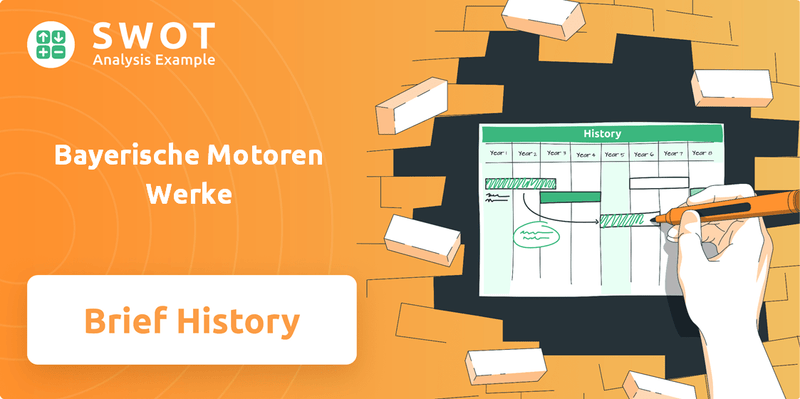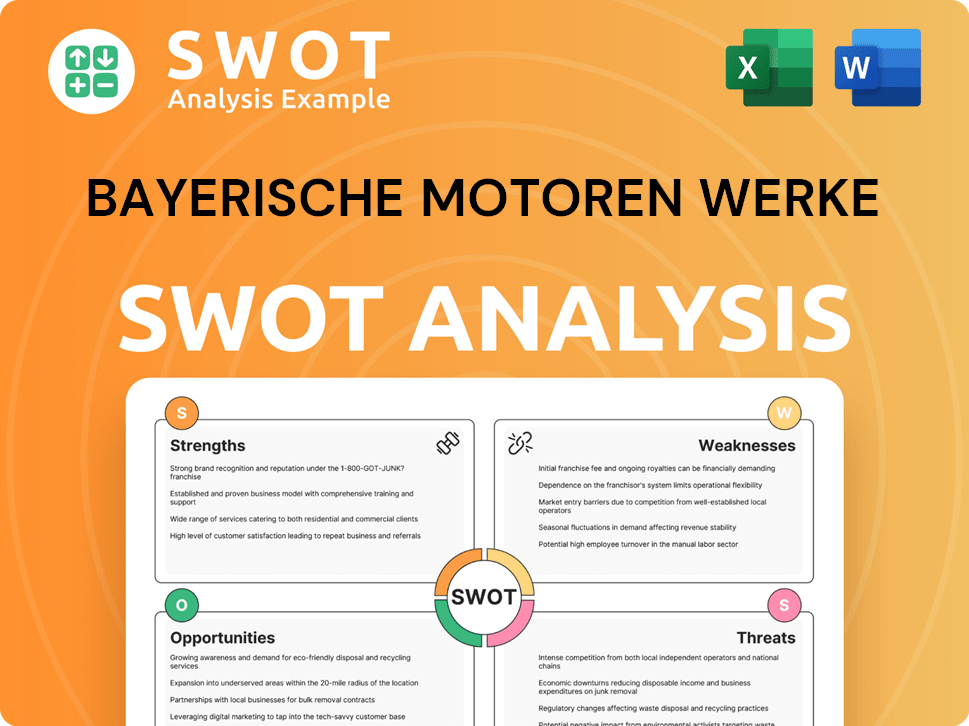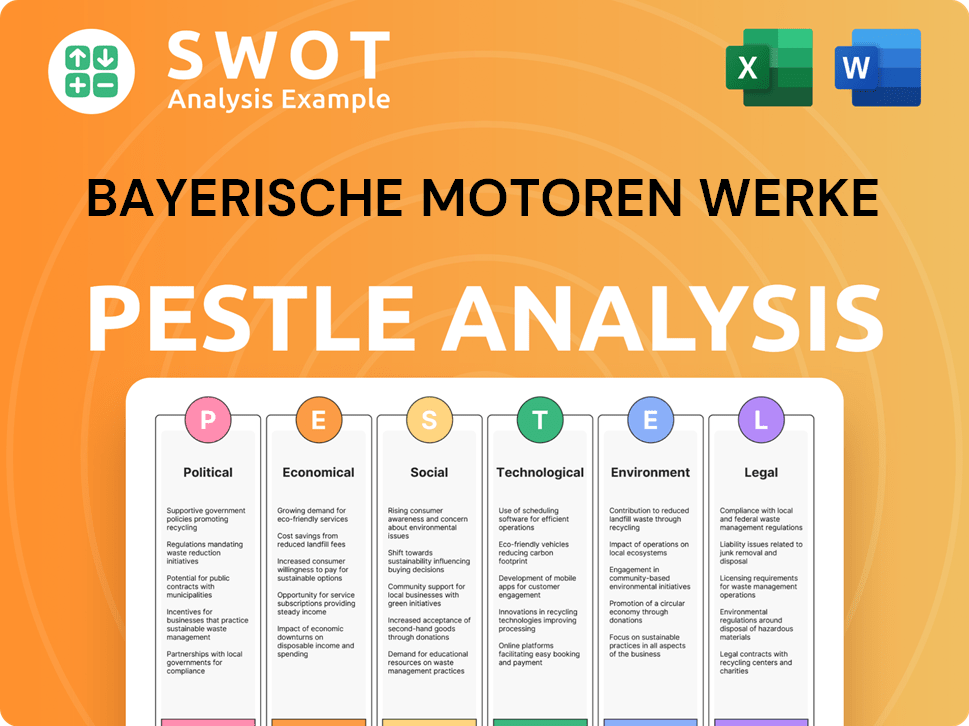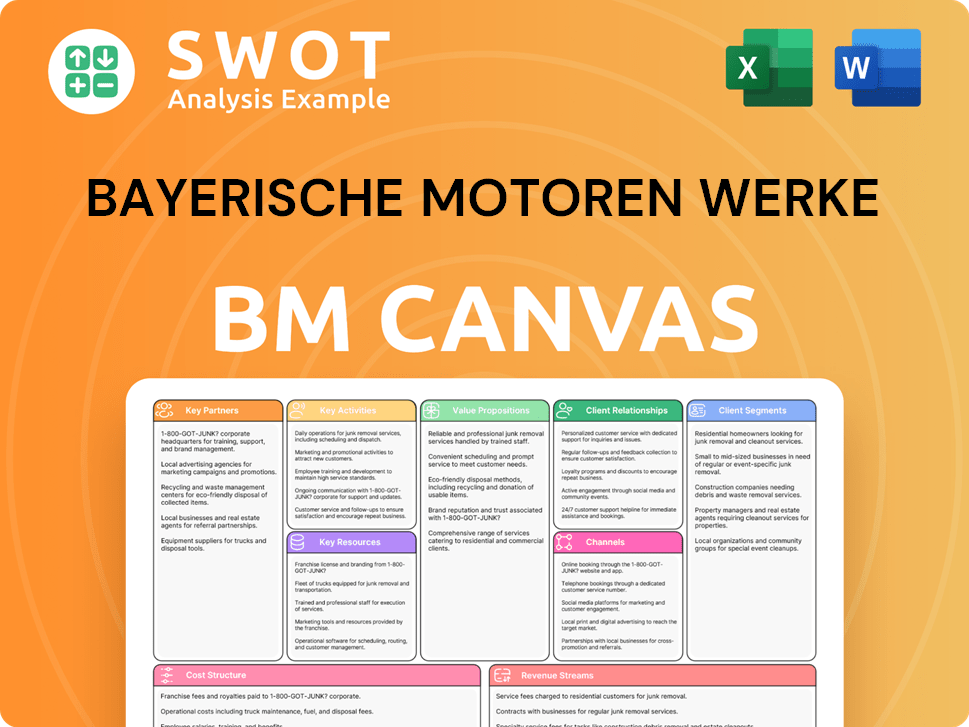Bayerische Motoren Werke Bundle
How did Bayerische Motoren Werke become a global automotive icon?
Embark on a journey through time and discover the captivating Bayerische Motoren Werke SWOT Analysis! From its inception in the heart of Germany, BMW's story is one of relentless innovation and a passion for engineering excellence. Uncover the pivotal moments that transformed a small aircraft engine manufacturer into a global leader in luxury mobility. Explore the key milestones that shaped the BMW history we know today.

Delving into the brief history of BMW reveals a fascinating narrative of adaptation and resilience. From its BMW origins in aircraft engine production to its expansion into motorcycles and automobiles, the German car manufacturer has consistently pushed boundaries. The BMW company's timeline showcases a commitment to performance and design, establishing the brand as a symbol of driving pleasure. Witness the evolution of BMW, from its early models to its current lineup of vehicles, and understand its impact on the automotive landscape.
What is the Bayerische Motoren Werke Founding Story?
The story of the Bayerische Motoren Werke AG, or BMW, began on March 7, 1916, in Munich, Germany. This marked the official founding of a company that would become a global icon in the automotive industry. The roots of BMW, however, extend further back, involving key individuals and their earlier ventures.
The company's origins are linked to the pre-existing businesses of Karl Rapp and Gustav Otto. Rapp Motorenwerke, established in 1913, and Flugmaschinenfabrik, founded in 1910, were crucial precursors to BMW. These companies were initially focused on aircraft engines, a critical sector during World War I. The demand for reliable and powerful aircraft engines during the war was the initial problem that BMW aimed to solve.
After Karl Rapp's departure due to financial difficulties, the company was reorganized and renamed Bayerische Motoren Werke GmbH in 1916. Franz Josef Popp became the first general director. Camillo Castiglioni, an Austrian financier, played a vital role in the company's early funding and strategic direction. The company's initial business model centered around the design and production of high-performance aircraft engines.
BMW's founding was heavily influenced by World War I, which created a high demand for aircraft engines. The company's early success was driven by its focus on innovation and reliability.
- The first significant product was the BMW IIIa aircraft engine, known for its altitude performance and reliability.
- The name 'Bayerische Motoren Werke' (Bavarian Motor Works) reflected its Bavarian roots and core business of engine manufacturing.
- Initial funding came from investors such as Camillo Castiglioni, who recognized the strategic importance of aircraft engine production.
- The rapid expansion of the aviation industry during World War I fueled BMW's early growth, creating a demand for advanced propulsion systems.
The Owners & Shareholders of Bayerische Motoren Werke have a rich history tied to the company's founding. The cultural and economic context of World War I significantly influenced BMW's creation. The war spurred rapid expansion in the aviation industry, creating a strong demand for advanced propulsion systems. This demand directly fueled BMW's early growth and success.
In the early years, BMW's focus was primarily on aircraft engines. However, after World War I, the company shifted its focus to other areas, including motorcycles and, eventually, automobiles. The company's ability to adapt and innovate has been a key factor in its longevity and success. BMW's early success in aircraft engines provided a foundation for the company's future in the automotive industry.
Bayerische Motoren Werke SWOT Analysis
- Complete SWOT Breakdown
- Fully Customizable
- Editable in Excel & Word
- Professional Formatting
- Investor-Ready Format

What Drove the Early Growth of Bayerische Motoren Werke?
Following the First World War, the Bayerische Motoren Werke faced new challenges. Restrictions imposed by the Treaty of Versailles on aircraft production spurred the company to diversify. This led to the development of motorcycles, marking a pivotal shift in the BMW company's focus.
In 1923, BMW introduced its first motorcycle, the R 32, at the Paris Motor Show. This model featured a flat-twin boxer engine and shaft drive, which became iconic. The R 32's success solidified BMW's entry into the automotive industry, albeit on two wheels.
BMW acquired the Eisenach automobile factory in 1928, gaining the infrastructure needed to manufacture cars. The first BMW car, the BMW 3/15, a licensed version of the Austin Seven, was produced in 1929. This marked the beginning of BMW's expansion into the automobile market.
The 1930s were a period of innovation for BMW, with the introduction of models like the BMW 303, featuring a six-cylinder engine. The BMW 328 sports car achieved significant racing success. These early models helped establish BMW's reputation for performance and quality.
BMW's entry into the automobile market was met with considerable interest. The company quickly began to develop its own distinct car designs. These early product launches and market reception laid the groundwork for BMW's future as a premium automotive brand.
Bayerische Motoren Werke PESTLE Analysis
- Covers All 6 PESTLE Categories
- No Research Needed – Save Hours of Work
- Built by Experts, Trusted by Consultants
- Instant Download, Ready to Use
- 100% Editable, Fully Customizable

What are the key Milestones in Bayerische Motoren Werke history?
The BMW history is marked by significant milestones, from its BMW origins in aircraft engine manufacturing to its evolution into a global German car manufacturer. The BMW company has consistently adapted to changing market conditions and technological advancements, establishing itself as a leader in the automotive industry. The BMW timeline reflects a journey of innovation, resilience, and strategic foresight, shaping its legacy.
| Year | Milestone |
|---|---|
| 1916 | Founded as an aircraft engine manufacturer, marking the initial phase of Bayerische Motoren Werke. |
| 1923 | Launched its first motorcycle, the R32, signaling its entry into the motorcycle market. |
| 1928 | Produced its first automobile, the Dixi, expanding its product range. |
| 1960s | Introduced the 'New Class' sedans, which revitalized the brand and set the stage for its modern identity. |
| 1970s | Launched the 3 Series, 5 Series, and 7 Series, establishing the core of its luxury vehicle lineup. |
| 1994 | Acquired Rover Group, a strategic move to expand into new segments, later divested in 2000. |
| 2010s | Introduced the BMW i3 and i8, marking its early foray into electric vehicles. |
BMW has consistently been at the forefront of automotive innovation, integrating cutting-edge technologies into its vehicles. These advancements have not only enhanced performance and driving experience but also set new standards in the industry.
The first production car with electronic engine management, the BMW 745i in 1979, showcased its technological leadership. This innovation improved engine efficiency and performance.
The 'New Class' sedans featured innovative independent suspension systems. This improved handling and ride quality, setting a new standard in the industry.
BMW pioneered the use of turbocharged engines in its vehicles, enhancing power and efficiency. This technology has been widely adopted across its model range.
The introduction of the BMW i3 and i8 marked its early foray into electric vehicles. The company continues to invest heavily in electric vehicle technology.
BMW has been at the forefront of ADAS development, integrating features like adaptive cruise control and lane-keeping assist. These systems enhance safety and driving convenience.
BMW has developed advanced connected car technologies, including in-car infotainment systems and remote vehicle control. These features enhance the overall user experience.
BMW has faced several significant challenges throughout its history, requiring strategic adaptations and innovative solutions. These challenges have shaped the company's trajectory and influenced its future direction.
After World War II, BMW faced immense difficulties, including factory destruction and production bans. The company's ability to recover and re-establish itself was crucial.
Intense competition, particularly from Mercedes-Benz, has consistently challenged BMW. The company has had to continually innovate to maintain its market position.
Economic downturns have impacted BMW's sales and profitability. The company has had to adapt its strategies to navigate these challenges.
The acquisition of Rover Group proved to be a significant financial burden, leading to its divestment. This strategic move highlighted the need for adaptability.
The transition to electric mobility and autonomous driving presents a major challenge. BMW is investing heavily in these areas to stay competitive.
Global supply chain disruptions have affected production. BMW has had to manage these challenges to maintain production levels.
Bayerische Motoren Werke Business Model Canvas
- Complete 9-Block Business Model Canvas
- Effortlessly Communicate Your Business Strategy
- Investor-Ready BMC Format
- 100% Editable and Customizable
- Clear and Structured Layout

What is the Timeline of Key Events for Bayerische Motoren Werke?
The Marketing Strategy of Bayerische Motoren Werke, or BMW, has a rich past filled with innovation and adaptation. From its BMW origins in aircraft engines to its current status as a leading German car manufacturer, the BMW company has consistently pushed boundaries. This brief history of BMW cars highlights key moments in the BMW history.
| Year | Key Event |
|---|---|
| 1916 | Founded as an aircraft engine manufacturer, marking the BMW company founding date. |
| 1917 | Registered as Bayerische Motoren Werke. |
| 1918 | Forced to cease aircraft engine production after World War I. |
| 1923 | Began motorcycle production, starting with the R32, a key moment in early BMW motorcycle history. |
| 1928 | Produced its first car, the Dixi, a significant milestone for the first BMW car model. |
| 1930s | Expanded car production, developing a reputation for sports cars and luxury vehicles. |
| 1939-1945 | Played a role in World War II, producing aircraft engines, impacting BMW's role in World War II. |
| 1945-1950s | Faced challenges in the post-war period, leading to BMW's post-war recovery. |
| 1960s | Launched the "New Class" of sedans, crucial to the company's revival. |
| 1970s | Expanded globally, establishing its presence in international markets. |
| 1994 | Acquired the Rover Group, including Rover, Mini, and Land Rover, although this venture was later divested, influencing BMW's acquisition of Rover. |
| 2000s | Entered Formula 1 racing, highlighting BMW's entry into Formula 1. |
| 2000s-Present | Focused on BMW's electric vehicle development and sustainable mobility. |
The BMW company is heavily investing in electric vehicles (EVs). The BMW's electric vehicle development includes expanding its BMW's current lineup of vehicles with new EV models. The company aims to have EVs make up a significant portion of its sales by the end of the decade. In 2024, BMW plans to increase its EV sales by over 15%.
Technological innovation remains a core focus. BMW is integrating advanced driver-assistance systems (ADAS) and connectivity features into its vehicles. They are also exploring new battery technologies to improve range and charging times. By 2025, BMW aims to have Level 3 autonomous driving capabilities in select models.
Expansion in key global markets is a priority. BMW is focusing on growth in China, the United States, and other emerging markets. They are adapting their product offerings to meet the specific demands of these regions. BMW plans to open new production facilities in strategic locations to support this global expansion.
Sustainability is a key aspect of BMW's future strategy. The company is committed to reducing its carbon footprint across its entire value chain. This includes using sustainable materials, improving manufacturing processes, and investing in renewable energy. By 2030, BMW aims to reduce its CO2 emissions per vehicle by at least 40%.
Bayerische Motoren Werke Porter's Five Forces Analysis
- Covers All 5 Competitive Forces in Detail
- Structured for Consultants, Students, and Founders
- 100% Editable in Microsoft Word & Excel
- Instant Digital Download – Use Immediately
- Compatible with Mac & PC – Fully Unlocked

Related Blogs
- What is Competitive Landscape of Bayerische Motoren Werke Company?
- What is Growth Strategy and Future Prospects of Bayerische Motoren Werke Company?
- How Does Bayerische Motoren Werke Company Work?
- What is Sales and Marketing Strategy of Bayerische Motoren Werke Company?
- What is Brief History of Bayerische Motoren Werke Company?
- Who Owns Bayerische Motoren Werke Company?
- What is Customer Demographics and Target Market of Bayerische Motoren Werke Company?
Disclaimer
All information, articles, and product details provided on this website are for general informational and educational purposes only. We do not claim any ownership over, nor do we intend to infringe upon, any trademarks, copyrights, logos, brand names, or other intellectual property mentioned or depicted on this site. Such intellectual property remains the property of its respective owners, and any references here are made solely for identification or informational purposes, without implying any affiliation, endorsement, or partnership.
We make no representations or warranties, express or implied, regarding the accuracy, completeness, or suitability of any content or products presented. Nothing on this website should be construed as legal, tax, investment, financial, medical, or other professional advice. In addition, no part of this site—including articles or product references—constitutes a solicitation, recommendation, endorsement, advertisement, or offer to buy or sell any securities, franchises, or other financial instruments, particularly in jurisdictions where such activity would be unlawful.
All content is of a general nature and may not address the specific circumstances of any individual or entity. It is not a substitute for professional advice or services. Any actions you take based on the information provided here are strictly at your own risk. You accept full responsibility for any decisions or outcomes arising from your use of this website and agree to release us from any liability in connection with your use of, or reliance upon, the content or products found herein.